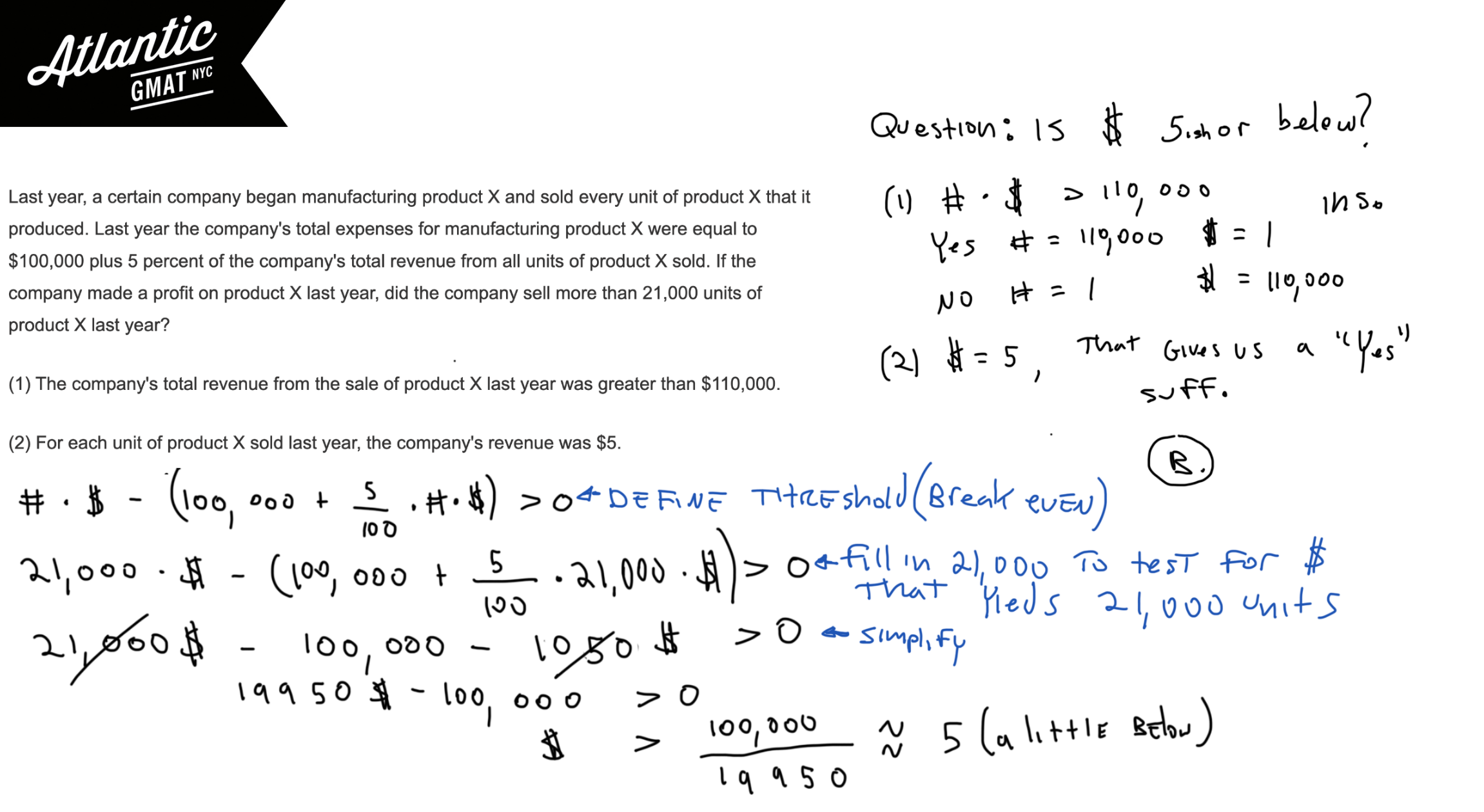Last year, a certain company began manufacturing product X and sold every unit of product X that it produced. Last year the company’s total expenses for manufacturing product X were equal to $100,000 plus 5 percent of the company’s total revenue from all units of product X sold. If the company made a profit on product X last year, did the company sell more than 21,000 units of product X last year?
(1) The company’s total revenue from the sale of product X last year was greater than $110,000.
(2) For each unit of product X sold last year, the company’s revenue was $5.
This is a very tough and time consuming question from the GMAT Official Guide (video solution below). It has a few things that make it extra challenging:
- It’s a long word problem so there’s a lot to chew through.
- It has multiple variables.
- It’s an inequality/threshold question
That said, conceptually it’s not hard at all. The basic idea: find the break even point or threshold and see if the statements help nail down whether you are above or below.
As always start by reading carefully. Do not rush to the statements. Data Sufficiency success is all about setup!
Let’s go ahead and define the question: Did the company sell more than 21,000 units of product X last year?
You might be tempted to stop there. But: keep going! How will we determine whether the company sold more than 21,000 units? What does that 21,000 depend on? What’s that you say???? The price? YES! This all hinges on the price per unit. So let’s get the inequality defined so we can figure out what price per unit of product X gets us above 21,000 units.
Here’s this part translated into an inequality: Last year the company’s total expenses for manufacturing product X were equal to $100,000 plus 5 percent of the company’s total revenue from all units of product X sold.
#*$ – (100,000 + 5/100*#*$) > 0
Next add the number of units for which you want the dollar amount. We want to know what $ comes out to with # = 21,000.
21,000*$ – 100,000 – 5/100*21,000*$ > 0
21,000*$ – 100,000 -1050*$ > 0
19950*$ -100,000 > 0
$ > 100,000/19950
That comes out to a little more than 5. So at 21,000 units that price is a bit more than $5. So if we’re 5 or below we’ve sold more than 21,000 units.
Let’s take a look at statement (1) The company’s total revenue from the sale of product X last year was greater than $110,000.
Always write out the algebra: #*$ > 110,000,
We need to know if # > 21,000. With statement (1) we can’t separate # from $. So:
Yes: 110,000 units for $1 each.
No: 1 unit for $110,000
Insufficient.
Statement (2) For each unit of product X sold last year, the company’s revenue was $5.
This helps. We defined the break even for 21,000 units at 100,000/19950 or a shade above 5. So if we know that revenue per unit X is $5 then the company has sold more than 21,000 units (as price goes down units sold goes up). Sufficient.
B.
Last year, a certain company began manufacturing product X Video Solution
Additional GMAT Data Sufficiency Thresholds, Yes/No, Inequality Practice Questions
These two questions are a bit different in content and not as wordy as the above but they share the bigger concept of defining the threshold/breakeven/inequality.
GMAT Data Sufficiency Thresholds/Inequalities Question of the Day 1
GMAT Question of the day Thresholds/Inequalities/Statistics
